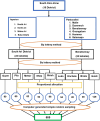Food insecurity and its determinants in pastoralist and agrarian communities in South Omo Zone, Southern Ethiopia: a community-based cross-sectional study
- PMID: 39463896
- PMCID: PMC11505120
- DOI: 10.3389/fpubh.2024.1482208
Food insecurity and its determinants in pastoralist and agrarian communities in South Omo Zone, Southern Ethiopia: a community-based cross-sectional study
Abstract
Background: Despite the implementation of different interventions, food insecurity remains a major public health issue in rural areas of Ethiopia. However, there has been limited evidence regarding food insecurity and responsible factors in rural areas of Ethiopia, particularly in South Omo, Ethiopia. Hence, this study aimed to assess food insecurity and determinants in agrarian and pastoralist communities of South Omo Zone, Southern Ethiopia.
Methods: A cross-sectional study was done among 605 randomly selected households in Benatsemay and South Ari districts from February 1 to 28, 2023. A standardized and validated Household Food Insecurity Access Scale (HFIAS) was used to measure food insecurity status. Data were entered using Epi-Info 7.1 and then transferred to SPSS V25 for analysis. To identify associated factors, a binary logistic regression model was employed. The strength of association was evaluated considering the adjusted odds ratio (AOR) and a 95% confidence interval (CI). A statistical significance was stated at p-value <0.05.
Result: A total of 597 participants were involved in the study with a response rate of 98.7%. The overall prevalence of food insecurity using HFIAS was 42.2% (95%CI: 38.2, 46.3%), among which mild, moderate, and severe food insecurity accounted for 17.4, 16.6, and 8.2%, respectively. Of pastoralists, 114 (47.1%) were food insecure whereas 138 (38.9%) were food insecure in the agrarian. Food insecurity was affected by household head sex (AOR = 1.73, 95%CI: 1.14, 2.62), high dependency ratio (AOR = 2.53, 95%CI: 1.53, 4.20), no formal maternal education (AOR = 2.11, 95%CI: 1.07, 4.18), productive safety net program (AOR = 2.00, 95%CI: 1.16, 3.46) and land ownership (AOR = 1.80, 95% CI: 1.19, 2.72).
Conclusion: Food insecurity was a significant problem in the study areas. Thus, it is crucial to improve female education, advance agricultural technologies, advocate family planning, and broaden productive safety net programs.
Keywords: Ethiopia; agrarian; determinants; food insecurity; pastoralist.
Copyright © 2024 Gujo and Modiba.
Conflict of interest statement
The authors declare that the research was conducted in the absence of any commercial or financial relationships that could be construed as a potential conflict of interest.
Figures



Similar articles
-
Household food insecurity and associated factors in South Ari district, Southern Ethiopia: A community-based cross-sectional study.PLoS One. 2023 Apr 12;18(4):e0284252. doi: 10.1371/journal.pone.0284252. eCollection 2023. PLoS One. 2023. PMID: 37043521 Free PMC article.
-
Food insecurity status and determinants among Urban Productive Safety Net Program beneficiary households in Addis Ababa, Ethiopia.PLoS One. 2021 Sep 27;16(9):e0256634. doi: 10.1371/journal.pone.0256634. eCollection 2021. PLoS One. 2021. PMID: 34570794 Free PMC article.
-
Level and determinants of food insecurity in East and West Gojjam zones of Amhara Region, Ethiopia: a community based comparative cross-sectional study.BMC Public Health. 2016 Jun 11;16:503. doi: 10.1186/s12889-016-3186-7. BMC Public Health. 2016. PMID: 27289456 Free PMC article.
-
Prevalence and associated factors for rural households food insecurity in selected districts of east Gojjam zone, northern Ethiopia: cross-sectional study.BMC Public Health. 2020 Feb 7;20(1):202. doi: 10.1186/s12889-020-8220-0. BMC Public Health. 2020. PMID: 32033552 Free PMC article.
-
Food insecurity in Farta District, Northwest Ethiopia: a community based cross-sectional study.BMC Res Notes. 2014 Mar 7;7:130. doi: 10.1186/1756-0500-7-130. BMC Res Notes. 2014. PMID: 24606757 Free PMC article.
Cited by
-
Co-occurrence of maternal anemia and child undernutrition in Ethiopia: multilevel analysis of analysis of EDHS data (2005-2016).BMC Public Health. 2025 Aug 11;25(1):2722. doi: 10.1186/s12889-025-23961-0. BMC Public Health. 2025. PMID: 40790471 Free PMC article.
References
-
- Peng W, Berry EM. The Concept of Food Security. In: Ferranti P, Berry, E.M., Anderson, J.R. (Eds.), editor. Encyclopedia of Food Security and Sustainability: Elsevier. (2019). 2:1–7.
-
- Gillespie S, Haddad L, Jackson R. HIV/AIDS, Food and Nutrition Security: Impacts and Actions. In: Nutrition and HIV/AIDS, Nutrition Policy Discussion Paper No. 20. Geneva: UN ACC/SCN, (2001). pp 31–46. Available at: http://www.unsystem.org/SCN/Publications/NPP/npp20.PDF
-
- Endalew B, Muche M, Tadesse S. Assessment of food security situation in Ethiopia: a review article. Asian J Agric Res. (2015) 9:55–68. doi: 10.3923/ajar.2015.55.68 - DOI
-
- FAO I, UNICEF, WFP, and WHO . The state of food security and nutrition in the world 2017. Building resilience for peace and food security. Rome, Italy: FAO; (2017).
MeSH terms
LinkOut - more resources
Full Text Sources
Medical

